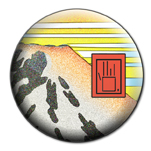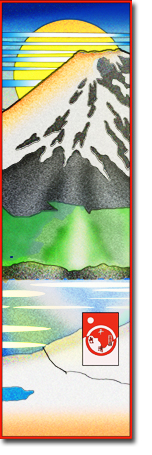On The Way: The Daily Zen Journal
Sayings and Dialogues
Kuei-shan (771-854) and Yang-shan his successor

Kuei-shan said, “The mind of a Wayfarer is plain and direct, without artificiality. There is no rejection and no attachment, no deceptive wandering mind. At all times seeing and hearing are normal. There are no further details. One does not, furthermore, close the eyes or shut the ears; as long as feelings do not stick to things, that will do.
“Sages since time immemorial have only explained the problems of pollution. If one does not have all that false consciousness, emotional and intellectual opinionatedness, and conceptual habituation, one is clear as autumn water, pure and uncontrived, placid and uninhibited. Such people are called Wayfarers, or free people.”
Kuei-shan was asked, “Is there any further cultivation for people who have suddenly awakened?”
Kuei-shan replied, “If they awaken truly, realizing the fundamental, they know instinctively when it happens. The question of cultivation or not is two-sided. Suppose beginners have conditionally attained a moment of sudden awakening to inherent truth, but there are still longstanding habit energies that cannot as yet be cleared all at once.
“They must be taught to clear away streams of consciousness manifesting habitual activity. That is cultivation, but there cannot be a particular doctrine to have them practice or devote themselves to.
“Having entered into the principle through hearing, as the principle heard is profound and subtle, the mind is naturally completely clear and does not dwell in the realm of confusion. Even if there are hundreds and thousands of subtleties to criticize or commend the times, you must gain stability, gird your loins, and know how to make a living on your own before you can realize them.

“In essence, the noumenal ground of reality does not admit of a single particle, but the methodology of myriad practices does not abandon anything. If you penetrate directly, then the sense of the ordinary and the sacred disappears, concretely revealing the true constant, where principle and fact are not separate. This is the buddhahood of being-as-is.”
Yang-shan asked Kuei-shan, “What is the abode of the real Buddha?”
Kuei-shan said, “Using the subtlety of thinking without thought, think back to the infinity of the flames of awareness. When thinking comes to an end, return to the source, where essence and form are eternal and phenomenon and noumenon are nondual. The real Buddha is being-as-is.”
Yang-shan said in a lecture, “You should each look into yourselves rather than memorize what I say. For beginningless eons you have been turning away from the light and plunging into darkness, so illusions are deeply rooted and can hardly be extirpated all at once.

“That is why we use temporarily set-up expedient techniques to remove coarse consciousness. This is like using yellow leaves to stop a child’s crying by pretending they are gold; it is not actually true, is it?
“I am now talking to you clearly about matters pertaining to sagehood, but do not focus your minds on them. Just turn to the ocean of your own essence and work in accord with reality. You do not need spiritual powers, because these are ramifications of sagehood, and for now, you need to know your mind and arrive at its source.
“Just get to the root, don’t worry about the branches—they’ll naturally be there someday. If you haven’t gotten the root, you cannot acquire the branches even if you study, using your intellect and emotions. Have you not seen how Master Kuei-shan said, ‘When the mentalities of the ordinary mortal and the saint have ended, being reveals true normalcy, where face and principle are not separate; this is the buddhahood of being-as-is.”
Kuei-shan (771-854) and Yang-shan his successor
Admonitions of Kuei-shan reflect some of the earliest of Zen writings. During the Sung dynasty (960-1278), this work was incorporated into a popular primer of Buddhism and subsequently was made the object of much study and commentary. Orally transmitted sayings of Kuei-shan and his successor Yang-shan appear in many classical anthologies of Zen works, and numerous dialogues between them are used as examples in major collections of teaching stories.
Excerpted from The Five Houses of Zen – Thomas Cleary 1997





Wayfarer is a term close to the heart of Daily Zen as it is an unadorned, simple description for entering a process that is timeless. Each generation has its wayfarers often hidden from plain view, who are committed to finding the clues of awakening, even though for us, it is an overstimulating, rapidly changing experience of “the world.”
There is no Resting
Who travels the Way
Heeds the Heart’s and the Way’s
Beginnings,
But the Way’s everywhere,
Without boundaries–
I’ll go till the rivers run dry,
Exhaust the peaks:
In the calm of the clouds I’ll sit,
And watch the moon light up the heavens.
Sesson Yibai (1290-1346)
Wayfarers come in all shapes, sizes, and states of action and non-action. Wherever we are in practice, the path of the Wayfarer is an ancient one, and at times it is encouraging to feel our place among these life-long seekers who never abandon the search.
Following the way of the sages together,
Elana, Scribe for Daily Zen